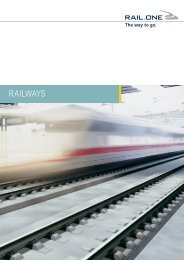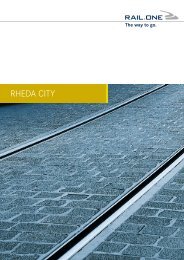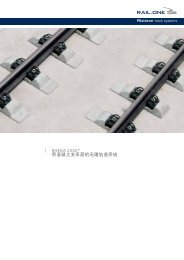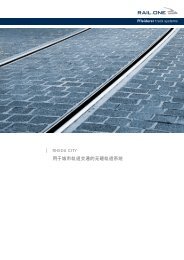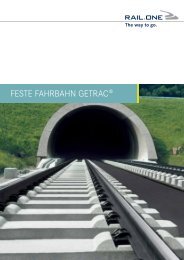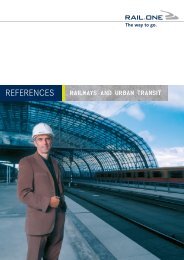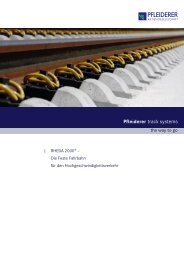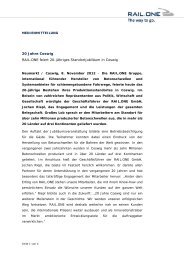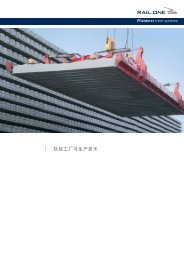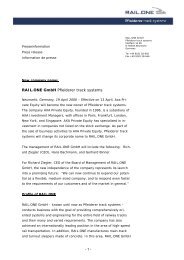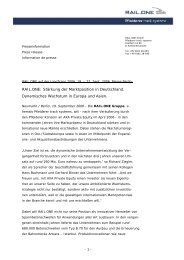rheda 2000® ballastless track system - RAIL.ONE GmbH
rheda 2000® ballastless track system - RAIL.ONE GmbH
rheda 2000® ballastless track system - RAIL.ONE GmbH
- No tags were found...
You also want an ePaper? Increase the reach of your titles
YUMPU automatically turns print PDFs into web optimized ePapers that Google loves.
The way to go.RHEda <strong>2000®</strong> BALLASTLESS TRACK SYSTEM
RHEDA <strong>2000®</strong>23On <strong>ballastless</strong> <strong>track</strong> toward railways ofOur contribution to high-speed technology: the RHEDA <strong>2000®</strong> <strong>ballastless</strong> <strong>track</strong> <strong>system</strong> is thedirect way to railways of the future. For heavy loads. At top speeds. With a maximum of safety.The basis for the RHEDA <strong>2000®</strong> is a <strong>track</strong> design first implemented in1972 on the line from Bielefeld to Hamm, Germany, at a station namedRheda. This original solution has continuously been further developedand optimized, without a change in basic principle. Over the past 10 ... 15years, <strong>ballastless</strong> <strong>track</strong> has developed from a customized design forniche applications, to standard technology for railway <strong>track</strong>s on linesused for transport at high speeds and with heavy loads.The RHEDA <strong>2000®</strong> <strong>ballastless</strong> <strong>track</strong> was used for the first time in Germanyin 2000, as pilot project on the new rail line between Erfurt and Halle-Leipzig, with a total length of approx. 1,000 m. Subsequently, it was installedon a further section 3 km long. As a result of the positive experiencegained in the project engineering, installation, and operation of theRHEDA <strong>2000®</strong> sections, Deutsche Bahn decided to employ over 180,000patented bi-block sleepers, based on RHEDA technology, for new constructionof the high-speed line – with its demanding engineering requirements– between Cologne and the Frankfurt Airport complex. In addition,new construction of the section of line between Nuremberg andIngolstadt, as part of the Nuremberg-Munich connection, was completedin good time for the FIFA World Football Cup events in 2006 in Ger-many. On this newly constructed section as well, approx. 75 km long, theRHEDA <strong>2000®</strong> <strong>system</strong> from <strong>RAIL</strong>.<strong>ONE</strong> was installed. Fortunately, thesenational projects were quickly and satisfactorily followed by a breakthroughof <strong>ballastless</strong> <strong>track</strong> technology in the form of RHEDA <strong>2000®</strong> onthe international stage of rail transport. One of the largest railway infrastructureprojects in Europe to date has been construction of the newDutch high-speed rail line HSL-ZUID, from Amsterdam, via Rotterdam, tothe Dutch-Belgian border. With the exception of a short section, the entireline – with a total length of 88 km – was constructed completely withRHEDA <strong>2000®</strong>.In 2006 <strong>RAIL</strong>.<strong>ONE</strong> won the contract for delivery of the bi-block sleepersrequired for the RHEDA <strong>2000®</strong> <strong>ballastless</strong> <strong>track</strong> <strong>system</strong> installed as partof new construction of the 28 km of double <strong>track</strong> in the Guadarrama Tunnelon the high-speed line from Madrid to Valladolid, in Spain. On thissame line, an additional 12 km of <strong>track</strong> was executed as RHEDA <strong>2000®</strong> inthe San Pedro Tunnel. Since February of 2008, this high-speed line hasbeen in operation for speeds of 350 km/h. Likewise, 15 km was installedin RHEDA <strong>2000®</strong> for the Sant Joan Despí Tunnel on the line from Madridto Barcelona, which was placed into service in December of 2007. In ad-
the futuredition, a number of <strong>ballastless</strong> <strong>track</strong> projects with an estimated length of15 to 20 km were completed in 2006 and 2007, as part of the Eje AtlanticoProject. These lines can be later converted from the Spanish to theEuropean gauge. For the section of the high-speed line from Perpignanto Figueras, <strong>RAIL</strong>.<strong>ONE</strong> delivered an additional 28,000 bi-block sleepersof the RHEDA <strong>2000®</strong> <strong>system</strong>, as well as over 28,000 linear metres ofturnout sleepers.Launching of <strong>ballastless</strong> <strong>track</strong> for high-speed rail traffic on the Asianmarket succeeded in 2004 with application of RHEDA <strong>2000®</strong> in new constructionof the high-speed line from Taipei to Kaohsiung, in Taiwan. Inaddition to the installation of Japanese <strong>ballastless</strong> <strong>track</strong> technology onthe open <strong>track</strong> sections, the demanding areas near and in the train stations(in a total of approx. 80 km <strong>track</strong> and 115 turnouts) were implementedwith the RHEDA <strong>2000®</strong> <strong>system</strong>. The <strong>RAIL</strong>.<strong>ONE</strong> Group additionallyparticipated in construction of the double-<strong>track</strong> passenger-dedicatedline (PDL) from Wuhan to Guangzhou in southeast China. Almost the entireline, with a length of approx. 1,000 km, was built with RHEDA <strong>2000®</strong>.Since December of 2009, trains use this high-speed line at speeds of350 km/h.
RHEDA <strong>2000®</strong>45
RHEDA <strong>2000®</strong>89End-to-end <strong>system</strong>structure on embankments,in tunnels, and on bridgesUniform <strong>track</strong> concrete layers with low structural height ensuresimplified line routing and installation.RHEDA <strong>2000®</strong> is characterized by a maximum degreeof flexibility. Throughout this <strong>track</strong> family, the commoncomponents are the basic <strong>system</strong> structure, the modifiedbi-block sleepers, and the monolithic cast-in-place supportingconcrete slab. This basic <strong>system</strong> is varied in accordancewith various sub-grade types, structural-engineering requirements,rail-support conditions, as well as cost-effectiveinstallation processes.On embankments, an additional bonded support layer – oftena hydraulically bonded layer – is installed in order to conformto the permitted levels of stress in the supporting layers andon the subgrade.In tunnels, with the great stiffness of the tunnel floors, onlyvery slight stresses develop in the <strong>track</strong> structure by the merenature of the configuration. As a result, no additional <strong>track</strong>supporting layers are required. In such cases, the concrete<strong>track</strong>-supporting layer is installed directly onto the <strong>track</strong> substructure.Further optimisation measures are possible both inthe concrete layer-thickness as well as in the content of reinforcement.The end-to-end characteristics of the basic <strong>system</strong>ensure, during installation, that neither the fundamental constructionprocedures nor the components must be exchangedor modified. This assures a constant high level of quality,throughout, including the construction work as well.In most cases, dilatation joints are provided at the ends ofbridges, and the <strong>track</strong> itself is also interrupted over thesejoints. In addition, economical and technical considerationsoften make it advantageous to decouple the <strong>track</strong> from thebridge supporting structure. In such cases, RHEDA <strong>2000®</strong> offersvarious possibilities for horizontal separation, and for fasteningby means of the concrete humps on the sleepers, or bypatented steel bolt anchors.Installation on bridgesreinforcement accordingto static requirementsreinforcement accordingto static requirementsprotection layerprotection layerConnection of the <strong>track</strong> concrete layer with the bridge structure by meansof negative cam platesConnection of the <strong>track</strong> concrete layer with the bridge structure by meansof positive cam plates in protection layer
Installation in tunnels9levelling concreteTrack concrete layer, installed on tunnel-floor fillTrack concrete layer, installed on levelling concreteThe definite advantages of RHEDA <strong>2000®</strong> are as follows:A maximum of cost effectiveness and reliability by utilisation of concrete sleepers as superior-quality precastconcrete building components in the critical area of the rail-seat zoneGreat precision of <strong>track</strong>-geometry parameters by application of precise concrete sleepersGreat adaptability to all types of substructure and models executed, by means of application of cast-in-placeconcrete for the concrete <strong>track</strong>-supporting layerGreat reliability as a result of technologically mature concrete engineering of the <strong>track</strong>-supporting layer for agreat diversity of climatic conditions and concrete standardsFlexible, high-performance installation procedures on the basis of simple installation steps that are reproduciblefor both manual as well as automated proceduresGreat added value by local production possibilitiesreinforcement accordingto static requirementsConnection of the <strong>track</strong> concrete layer with the bridge structure by meansof anchor dowels
RHEDA <strong>2000®</strong>1011Additional <strong>system</strong> solutionsTurnouts with optimized structuraldesigntechnologyWith the objective of end-to-end <strong>system</strong> engineeringfor <strong>track</strong>s and turnouts for the RHEDA<strong>2000®</strong> <strong>ballastless</strong> <strong>track</strong> <strong>system</strong>, extensive adaptationto reduced <strong>track</strong> structural height representedan essential step in sleeper design.The key aspect of this development was designand dimensioning of a concrete turnout sleeperbased on the B 355 bi-block sleeper. The GWS05 lattice-truss turnout sleeper currently representsthe optimized state of <strong>system</strong> development.With its end-to-end <strong>system</strong> engineering,this sleeper assures effective provision of the recessesbelow the base of the rail that are necessaryfor the turnout drive, as well as the contin-uous reinforcement of the <strong>track</strong> concrete layer(approximately in the centre of the <strong>track</strong> crosssection).This solution achieves homogeneousheight configuration in <strong>track</strong> and turnouts, andcorrespondingly reduces the weight involved.For project engineering and installation on theconstruction site, this means considerable timesavings and cost reduction. The uniform <strong>system</strong>sengineering features allow integration of all<strong>track</strong> substructure variations and conditions intothe design. In Taiwan, for example, <strong>RAIL</strong>.<strong>ONE</strong> implementedcomplete train-station <strong>system</strong>s witha great number of turnouts and platform connections,on viaducts by means of pile-supportedconstructions, or in tunnel areas.Rail expansion jointsThe turnout sleeper for the RHEDA <strong>2000®</strong> <strong>ballastless</strong><strong>track</strong> <strong>system</strong> also offers a safe, reliable,robust, and at the same time flexible basis forvarious types of rail expansion joints. The GWS05 sleeper is the heart of the <strong>system</strong>, and providesstable, requirement-satisfying, and exactmounting points - especially for the respectiveinstallation components of a rail expansionjoint. The monolithic concrete <strong>track</strong> layer canbe adapted to the special requirements encountered,especially in the immediate vicinity of thebridge joint. A number of major projects have alreadybeen planned and executed in the RHEDA<strong>2000®</strong> <strong>system</strong> with special transition elements.subsoil
TransitionsThe installation of <strong>ballastless</strong> <strong>track</strong> <strong>system</strong>s demandsspecial attention for the transitions betweenballasted and <strong>ballastless</strong> <strong>track</strong> <strong>system</strong>s.With the RHEDA <strong>2000®</strong> <strong>system</strong>, numerous <strong>system</strong>-optimizeddetails enable stiffness adaptationin the rail fastenings and in the ballast, at suchtransitions from <strong>ballastless</strong> to ballasted <strong>track</strong>.As a rule, these solutions include the first step ofmultistage gluing of the ballast, in addition to anextension of the hydraulically bonded layer. Thistechnique increases the stiffness of the ballasted<strong>track</strong> <strong>system</strong>. In addition, a special pre-stressedsleeper with highly elastic rail fastening is installedin the ballasted <strong>track</strong>. This arrangementenables an increase in stiffness, in several stages,between the <strong>ballastless</strong> <strong>track</strong> and the ballastedsection. As an option, it is also possible to configureauxiliary rails: both for these special turnouts,as well as on the <strong>ballastless</strong> <strong>track</strong>. This likewisereduces the difficulties otherwise encountered atthe interfaces between ballasted and <strong>ballastless</strong>sections. The RHEDA <strong>2000®</strong> <strong>system</strong> accordinglyoffers an optimal solution, with uniform <strong>system</strong>engineering for all areas of application.Road-Vehicle Access SystemNew safety regulations in Europe stipulate thataccess for vehicles must now be ensured in railwaytunnels for all types of road vehicles (passengercars and lorries). As a result, a road-vehicleaccess <strong>system</strong> was developed for the RHEDA<strong>2000®</strong> <strong>ballastless</strong> <strong>track</strong> <strong>system</strong>. As an adaptivemeasure, this access <strong>system</strong> can be installed directlyonto the <strong>track</strong>. The emplacement of precastconcrete slabs onto B 355 bi-block sleepersprovides an operating surface for road vehiclesat a defined level below the top of rail. This developmentallows passenger cars and lorrieswith up to 10-tonne axle loads to use the surfaceas a roadway without restriction. An additionaladvantage of the precast parts results from thefact that smaller connecting elements in the vicinityof the rails and the rail-fastening elementscan be removed to allow easy performance ofobligatory maintenance on these components.Electromagnetic compatibility (EMC)Ballastless <strong>track</strong>s, with their reinforced concretelayers, have substantial electromagnetic properties.In their development, it is necessary to considereffective measures against lightning andcatenary line breakage. These measures involvegrounding elements (equipotential bonding).Modifications or extensions necessitate regularinspection of these elements.In high-speed rail traffic, unrestricted compatibilityis absolutely essential between train control<strong>system</strong>s and the <strong>ballastless</strong> <strong>track</strong>. Control<strong>system</strong>s operate with transmission <strong>system</strong>s anduse electromagnetic signal transmitters and/orsignal receivers. These control <strong>system</strong>s functiondirectly in the reinforced-concrete <strong>track</strong> layersthemselves (e.g., LZB and ETCS), or in the directvicinity of these layers (e.g., UM 71 etc.). It is crucialto study the effects of longitudinal reinforcement,since it represents the primary attenuatingelement.The RHEDA <strong>2000®</strong> <strong>system</strong> has been tested forthe most widely employed train control and management<strong>system</strong>s: i.e., for the LZB in Germany,the ETCS trans-European high-speed train network,and the UM 71 in France and Asia. TheRHEDA <strong>2000®</strong> <strong>system</strong> has been approved as observingthe respective stipulated parameters.On the basis of its simple structure and constructionmethods, it is possible to quickly andeconomically conform to all the requirements oftrain control <strong>system</strong>s now in use.
RHEDA <strong>2000®</strong>1213Noise and vibrationprotectionNoise protectionFor significant reduction of airborne noise propagation,it is possible to install special noise-absorber<strong>system</strong>s for <strong>ballastless</strong> <strong>track</strong> <strong>system</strong>s.This solution achieves good noise-engineeringparameters, even for half-surface installation inthe outdoor areas of the rails.Vibration protectionThe increase in train speeds, axle loads, andtraffic volumes on current train lines has also ledto increases in the noise and vibration to whichthe surroundings are subjected. Irregularitiesbetween rail and wheels, as well as the dynamicdeformation of <strong>track</strong>s when rolling stock passes,introduce vibrations into the subgrade. Thesevibrations are propagated into adjoining buildingstructures, which vibrate to lesser or greaterdegree. Secondary airborne noise can likewiseproduce disturbances. One of the most effectivemeasures against the development of structuralbornenoise and vibrations is mass-spring <strong>system</strong>s.These <strong>system</strong>s attenuate the transmissionof vibrations into the surroundings. The characteristicsof the amplification function of singlemassoscillators play a key role in the design ofmass-spring <strong>system</strong>s. The use of mass-spring<strong>system</strong>s is advisable especially in densely developedareas sensitive to vibrations.Mass-spring <strong>system</strong>s can be implemented inlight, medium-heavy, or heavy models. Lightmass-spring <strong>system</strong>s are mounted on eitherstrip supports or entire-surface supports madeof elastomer matting. For heavy mass-spring<strong>system</strong>s, individual supports in the form of elastomerblocks or steel springs are employed. Thedeeper the frequency of the vibration to be reduced,the higher the required mass of the mass<strong>track</strong> concrete layer. Here, the structure ofthe RHEDA <strong>2000®</strong> <strong>ballastless</strong> <strong>track</strong> <strong>system</strong> offersbenefits to the entire <strong>system</strong>: the appreciablemass of the <strong>track</strong> concrete layer, with itsbi-block sleepers embedded in concrete, contributessignificantly to attenuation of vibrations.In addition, the RHEDA <strong>2000®</strong> <strong>system</strong> – as a resultof its structural properties insensitive to waterand erosion – is well suited for applicationboth on open <strong>track</strong> sections, as well as in tunnels.As a result, many and various forms of themass-spring <strong>system</strong> are feasible: light, mediumheavy,or heavy models, with the respectively requiredsupport types of individual, strip, and entire-surfaceelastomer support.This great degree of design and adaptation flexibilitymakes the RHEDA <strong>2000®</strong> <strong>ballastless</strong> <strong>track</strong><strong>system</strong> on a mass-spring <strong>system</strong> an optimal solutionfor satisfying all requirements placed on vibrationprotection and operational functionality.The RHEDA <strong>2000®</strong> <strong>ballastless</strong> <strong>track</strong> <strong>system</strong> on amass-spring <strong>system</strong> has already been installedin numerous projects, in the form of variousmodels: e.g., in the Cologne-Bonn Airport Link(as a heavy mass-spring <strong>system</strong>), in the BerlinNorth-South Link (with light to heavy massspring<strong>system</strong>s), and in the S-Bahn heavy-railurban transit <strong>system</strong> in Unterfoehring, on theoutskirts of Munich (light mass-spring <strong>system</strong>).Application of the single-mass oscillator principle in the RHEDA <strong>2000®</strong> <strong>track</strong> type on a mass-spring <strong>system</strong>
Urban transitRHEDA CITYThe RHEDA CITY <strong>track</strong> <strong>system</strong> has been designedespecially for use with tram <strong>system</strong>s.This <strong>system</strong> is based on the same fundamentalfunctional principles as all <strong>track</strong> models in theRHEDA family, especially the RHEDA <strong>2000®</strong> <strong>system</strong>.The simple installation techniques producegood <strong>track</strong> positioning over the long term, withoutreworking. The <strong>system</strong> can be covered withasphalt, concrete, or paving stones, as desired.The latest development of RHEDA CITY is thevegetated (green) variation.Measures to reduce stray currentWithin the context of railway engineering, straycurrents are currents that do not flow throughthe running rails of the <strong>track</strong>, as intended, butalong other paths back to the rectifier substations:e.g., through the earth. Stray current cancause considerable corrosive damage not onlyto the running rails, but also to nearby facilitiesthat do not belong to the railway operationsthemselves: for example, the reinforcement ofconcrete elements, and piping made of metal.In order to reduce stray current and the negativeeffects that it causes, <strong>RAIL</strong>.<strong>ONE</strong> has placed greatemphasis on effective electrical insulation of therunning rails with respect to the earth, in the developmentof its <strong>ballastless</strong> <strong>track</strong> <strong>system</strong> RHEDACITY, for employment with tram <strong>system</strong>s in urbantransit. The primary design principle implementedhere was the effective combinationof electrically insulating <strong>system</strong> components– such as rail-base coating, rail chamber elements,and rail joint filling compound.RHEDA CITY has been installed in numerous cities.Laboratory studies and measurements onrail lines in operation have verified the effectivenessof the above-stated measures for reductionof stray current.RHEDA MRTThe RHEDA MRT <strong>ballastless</strong> <strong>track</strong> <strong>system</strong> wasespecially developed for use with undergroundand surface mass rapid transit networks. The basicprinciple corresponds to the RHEDA <strong>2000®</strong>high-speed <strong>system</strong>, with modification of the individualcomponents to meet the requirementsof urban mass rapid transit: adaptation that hassignificantly reduced the structural height andweight of the <strong>system</strong>. The <strong>system</strong> is thereforeoptimally suited for use in tunnels, with simultaneousenhancement of quality, safety, and permanence.The MRT models can also be implementedas mass-spring <strong>system</strong>s.
RHEDA <strong>2000®</strong>1415DESIGN & ENGINEERINGBallastless <strong>track</strong> <strong>system</strong>s are special structures that arehistorically still very recent in comparison to conventionalcivil-engineering works such as normal buildings,bridges, and tunnels. In many cases they cannot be designedand tested according to the generally accepted rulesof good engineering practice. Particularly in the area of highspeedrail traffic, they are subject to extremely high safetystandards. With respect to the budgetary and time-schedulingconstraints applied in major international projects, alternativesare available to long-term test series: i.e., other methodsthat have for many years now been successfully practicedin other fields of railway work such as train control and management<strong>system</strong>s. For implementation of these methods - forexample, as set forth in CENELC standards, particularly in EN50126 - <strong>track</strong> design must follow a process that verifiably assuresthe safety and the reliability of the entire <strong>system</strong> and itssub-<strong>system</strong>s, in addition to conformity with purely engineeringrequirements. This process must above all satisfy two aspects:reliable break-down of the <strong>system</strong> into components,as well as step-by-step development, detailing, and checking.
Quality managementTop quality goes without saying for <strong>RAIL</strong>.<strong>ONE</strong>, and hasbeen a core element of corporate policy from the beginning.Convincing evidence here is certification in accordancewith DIN EN ISO 9001: all work processes are subjectto continuous monitoring – beginning with planning and engineering,including production, and extending to logistics anddelivery. Documentation is by <strong>RAIL</strong>.<strong>ONE</strong>’s own concrete laboratories,all of which are monitored by official testing bureaus.The prime objective of the <strong>RAIL</strong>.<strong>ONE</strong> quality management<strong>system</strong> is the assurance of conformity of all deliveredproducts, and ongoing enhancement of the satisfaction of itscustomers. Deutsche Bahn AG has likewise recognized thecompetence and reliability of <strong>RAIL</strong>.<strong>ONE</strong>: classification as Q1provider is the highest quality level, achieved for years by<strong>RAIL</strong>.<strong>ONE</strong>. Ongoing RAMS tests for <strong>system</strong>s and <strong>system</strong> componentsfurther highlight the reliability and availability of<strong>RAIL</strong>.<strong>ONE</strong> products.Production in foreign countries requires in all cases harmonisationof the standards and technical terms of deliveryapplicable in Germany and in the respective foreign countries.The requirements resulting from this harmonisation decidethe choice of local raw materials, concrete qualities, andproduction processes. Proof of conformity of raw materials,the concrete quality achieved, and the sleeper quality withthe requirements used as basis – as well as certification ofproduction as per DIN EN ISO 9001: all of this leads to officialnational approval.The low structural height, the high <strong>track</strong>-geometry qualityfor assurance of functionality and long life cycles, as well asthe permanent bonding of <strong>track</strong> concrete layer and sleeperreinforcement – these are the quality characteristics of theRHEDA <strong>2000®</strong> <strong>ballastless</strong> <strong>track</strong> <strong>system</strong>. Satisfaction of thesestrict demands requires perfect interaction of good <strong>system</strong>design with flawless execution of construction. Integratedquality assurance guarantees <strong>RAIL</strong>.<strong>ONE</strong> objectives: close supervisionof the entire process beginning with engineering, includingin-house production monitoring, up to execution onthe construction site.key tasks involved in <strong>track</strong> quality assurance:Checking of detail design and construction drawings, andof the geodetic projectVerification of the quality management of the manufacturersof sleepers and other componentsCertification of the concrete supplier(s) for the <strong>track</strong>Checking, documenting, and clearance of the <strong>track</strong>-positioningstate before concretingChecking of delivery documents and conformity of the concretesuppliedChecking of the concrete technology, processing, and curingin the <strong>track</strong>Supervision of rail handling: laying, welding, and grindingRe-checking of the <strong>track</strong> positionChecking of the final documentationPreparation of the quality reportTurnover with the line operator and other participants
RHEDA <strong>2000®</strong>1617Installation techniquesMaximum precision during installation ensures exactand long-lasting <strong>track</strong> positioningThe great majority of the bi-block sleepers of the RHEDA <strong>2000®</strong> <strong>system</strong>are produced locally in especially constructed production plants.This arrangement reduces transport costs to a minimum. As a result of thesimple installation technology, which does not require special equipment,local <strong>track</strong> and civil-engineering companies can install the RHEDA <strong>2000®</strong>. Inaddition, a surveying technique especially developed for the RHEDA <strong>2000®</strong><strong>system</strong> assures great exactness of <strong>track</strong> position and geometry. The alignmenttechniques used here – using spreader bars and spindle-base adjustmentunits – enable precise alignment and securing of the <strong>track</strong> panel, evenunder the most unfavourable of construction-site installation conditions.The spreader-bar adjustment <strong>system</strong> involves a combined technique consistingof the following two elements: vertical adjustment by means ofspindles attached at the ends of the sleepers, and horizontal adjustmentby special spreader bars at the centre of the sleepers. The spindle adjustmentsupports the <strong>track</strong> panel directly at the rail base and enables bothvertical as well as horizontal <strong>track</strong>-panel alignment.With both techniques, the adjustment procedures are completed with approvalgranted by the survey engineer. The next step includes the castingof the sleepers into a <strong>track</strong> concrete layer. Here, two measured points onthe rail may at intervals of 5 m have position or height differences of noGeneral overview of RHEDA <strong>2000®</strong> production sequences, consisting of manual and mechanised steps of workPreparation ofthe substructureAssembly of the<strong>track</strong> panelRough alignmentof the <strong>track</strong> panelInstallation ofthe <strong>track</strong> formworkEmbankmentPlacing of the frost protection layerusing conventional constructionmachinesPlacing of the hydraulically bondedlayer using conventional constructionmachinesAssembly on sitePlacing reinforcementPlacing of single sleepers and installationof <strong>track</strong> reinforcementInstallation of rails (temporary or final)Manual rough alignmentLifting and rough alignment of the <strong>track</strong>panel using manual devices (rail jacks,<strong>track</strong> alignment frames, etc.) and surveyinstrumentsPossible kinds of formworkIndividually / manually (on site) manufacturedformwork (e.g., timber formwork)Pre-fabricated formwork <strong>system</strong> elements(usually of steel)Pre-fabricated (steel) formwork <strong>system</strong>elements with integrated rails forconstruction vehiclesCivil structures• Preparation of the civil structuresurface and the possible <strong>track</strong> fixationelements according to the individualsub-/superstructure designPre-assemblyPre-assembly of the <strong>track</strong> panels onspecial sitesTransport and placing of the complete<strong>track</strong> panels to the final installationlocationAutomatic rough alignmentLifting and rough alignment of the <strong>track</strong>panel using automatic devices: e.g.,rough alignment machines, remotelycontrolled by electronic surveyinginstrumentsLOGISTIC ACTIVITIES
more than ± 2 mm with reference to each other – dimensions that demanda maximum of exactness in concrete construction. The top-down installationprocedure inherent to this <strong>system</strong> can optimally satisfy these exactingrequirements. Production of special sleepers by <strong>RAIL</strong>.<strong>ONE</strong> – with manufactureand installation of the RHEDA <strong>2000®</strong> <strong>system</strong> by local constructioncompanies – allows optimal economical cost/benefit relationship: both for<strong>RAIL</strong>.<strong>ONE</strong> as well as for the local industry.Final alignment ofthe <strong>track</strong> panelPlacing of the <strong>track</strong>concreteSupplementaryworking stepsVertical final alignmentVertical final alignment using the verticaladjustment spindles of the spindlebracketsAlignment of the required superelevation,with adjustment of the proper angle ofthe base plates of the spindle bracketsManual concrete placingManual concrete placing using concretebucket and craneManual concrete placing using concretepumpConcrete curingWetting of the concrete surfaceCoating of the concrete surface withcuring liquidCovering of the concrete surface withplastic or textile sheetsHorizontal final alignmentHorizontal final alignment using thehorizontal adjustment screws of thespindle bracketsAutomatic concrete placingConcrete placing using an automaticconcrete placing unit: e.g.,concreting unitAvoiding stress in unset concreteLoosening of the rail fasteningsLOGISTIC ACTIVITIES
RHEDA <strong>2000®</strong>1819
RHEDA <strong>2000®</strong> – a proven <strong>system</strong>with worldwide reference projectsMaximum reliability and safety in planning,construction, and operationOver the past 40 years, <strong>ballastless</strong> railway <strong>track</strong> has developedfrom a niche product to internationally proven standardtechnology in the new construction of railway lines with specialrequirements. One of the most influential <strong>system</strong>s for applicationof <strong>ballastless</strong> <strong>track</strong> with main-<strong>track</strong> sleepers is theRHEDA family of <strong>ballastless</strong> <strong>track</strong>s. <strong>RAIL</strong>.<strong>ONE</strong> holds the patentsfor the latest and highest development stage of theRHEDA <strong>2000®</strong> model and of the RHEDA Berlin <strong>system</strong>.The RHEDA <strong>2000®</strong> <strong>system</strong>, as well as other models withRHEDA technology, have until now been installed in more than10 countries, in more than 2,000 km of <strong>track</strong>s, and for morethan 150 turnouts and rail expansion joints. The required officialapproval has been obtained for each of the applications ofRHEDA <strong>2000®</strong>, including a Certificate of Conformity in accordancewith European Union Directive 96/48 (Version 2001), forthe line from Amsterdam to the Belgian border. The use of theRHEDA <strong>2000®</strong> <strong>system</strong> for the most widespread high-speedtrain <strong>system</strong>s – the Shinkansen, TGV/Thalys und ICE – and forthe LZB, ETCS, and UM 71 signal <strong>system</strong>s – verifies the compatibilityof this <strong>ballastless</strong> <strong>system</strong>. On the basis of the extensiveand widely varied experience gained with the RHEDA<strong>2000®</strong> <strong>system</strong>, it offers a maximum of security for every user:starting with the planning and approval phase, including installation,and extending to operation.The next technological step: <strong>ballastless</strong> <strong>track</strong>without continuous reinforcementAn additional <strong>system</strong> solution is the new <strong>ballastless</strong> <strong>track</strong> <strong>system</strong>without continuous reinforcement. In its structural designand functional principle, it matches the current stateof the art in construction of transportation infrastructure –whereas, in contrast to the RHEDA <strong>2000®</strong> <strong>system</strong> until now,it has eliminated continuous reinforcement. This eliminationof reinforcement enables shortening of construction time andreduction in costs. This modification has also minimized unwantedeffects of the reinforcement on railway signalling <strong>system</strong>sand on the electrical grounding facilities. Analogous toroadway construction, this new <strong>track</strong> <strong>system</strong> features provisionof lateral dummy joints that enable controlled formationof cracks in the concrete <strong>track</strong>-supporting layer. These jointsare sealed to prevent the intrusion of water. The transfer oflateral forces, previously enabled by aggregate interlock, isnow provided by bolt anchors. Furthermore, the higher concretegrade C35/45 can be used, instead of the grade C30/37employed until now. This achieves greater resistance to frost,which in turn leads to longer life cycles. Ballastless <strong>track</strong> withoutcontinuous reinforcement can be executed either with orwithout a hydraulically bonded layer.<strong>track</strong> joints (filled withsealing compound)concrete <strong>track</strong>-supportinglayer 240 mmprovision of bolt anchorfittings for the jointshydraulically bonded layer 300 mmballast supporting layer



